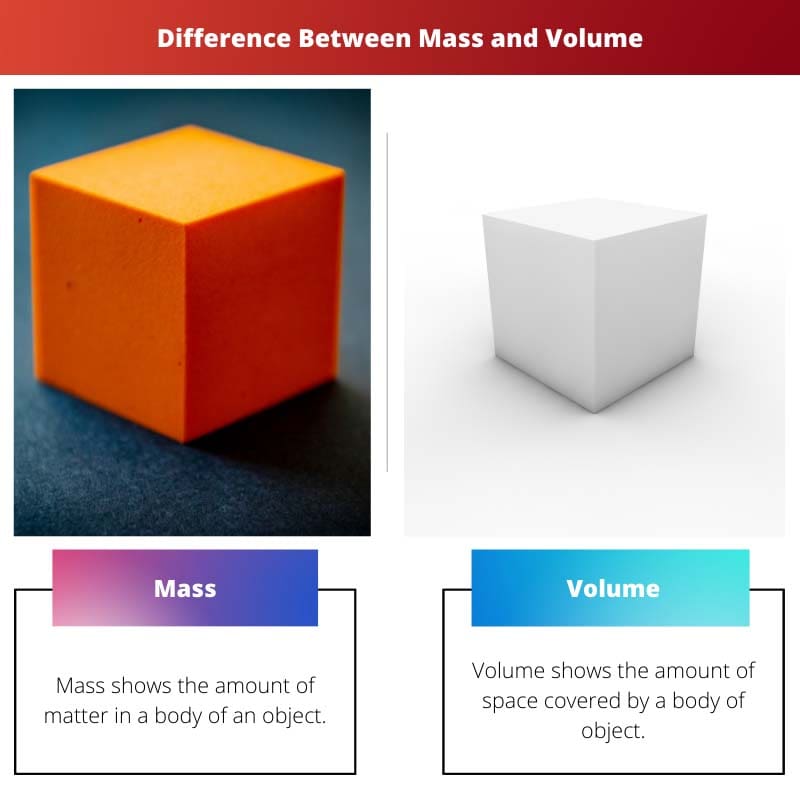Every object is in a different shape and different structure and has different characters and properties. Likewise, it needs different units to measure the object.
If an object undergoes various tests and research, the first of all is to know about its character towards nature and against nature.
The second is how much space is needed in this world or how much space is covered by this particular object. For all that, the two essential things are mass and volume.
Key Takeaways
- Mass measures the quantity of matter in an object, while volume refers to the amount of space an object occupies.
- Mass remains constant regardless of location, whereas volume can change with temperature, pressure, or physical state changes.
- Scientists use kilograms for mass and liters or cubic meters for volume.
Mass Vs Volume
Mass is a measure of the amount of matter in an object. It is measured in units such as grams (g) or kilograms (kg) and is a scalar quantity. Volume is a measure of the amount of space occupied by an object or substance. It is measured in units such as litres (L) or cubic meters (m3).

The mass is dependent on volume and is just an object’s accelerated force and gives the weight of the body without gravity.
Since it needs to calculate the single things in physics just compare it to other related things to get the perfect opinion on mass. The word mass is called matter.
The volume is nothing amount of space covered by an object. Simply shows the total amount of space covered by the particular object.
You can easily differentiate things by remembering formulas and the difference table helps you compare easily and understand easily.
Comparison Table
| Parameters on Comparison | Mass | Volume |
|---|---|---|
| Definition | Mass shows the amount of matter in a body of an object | Volume shows the amount of space covered by a body of object |
| Value | Physical value | Geometric value |
| Solid | The quantity of matter inside a solid is called its mass. | The space of an object covered is called its volume |
| Liquid | The liquid of mass is the weight of the container | the volume of container shows volume of liquid substance that is in inside of it |
| State | Mass is a fixed property of a body of an object | The volume of a substance change as state of the substance |
| SI unit | Kilogram | Cubic meter |
What is Mass?
Every substance is made from matter(atoms or molecules). Mass is nothing but how much matter is in substance. Changing the shape of an object won’t change the mass, but removing a part from the object will certainly reflect a change in mass.
Mass is a physical quantity and is calculated for its physical value, it shows the amount of matter in the body of an object. Mass is calculated in kilograms which is the Si unit of Mass.
It is a dimensionless scalar quantity and changes according to the density and volume of an object or the matter inside the object gets increased the mass also gets increased. An interesting fact is empty vacuums have no mass, but the mass is energy.
Equation
Mass=Density*Volume
The mass gets increase when the object is in motion.. but the person who measured the mass will move along with the object and can not observe the changes.
By the equation, F=Ma force is directly proportional to mass results if external force or additional force applied results in an increase in mass.
In simple the higher the mass of a body of an object, the smaller the change produced by an external force. If the object rearranges itself, it doesn’t affect the mass.

What is Volume?
Every substance occupies (takes up) some space. Volume is nothing, but it tells how much space a substance occupies. Changing the shape of an object is reflected in the amount of space occupied by the particular object.
Volume is the geometric quantity it is calculated for its geometric value, and it shows the amount of space occupied by the body of an object.
Since it is measured by the geometric value, it takes the 3 dimensions of an object and substitutes them in the formula of finding volume.
Formula:
V=l*b*h
V-volume
L-Length
B-Breath
H-height
Since it is measured by the geometric value it takes the 3 dimensions of an object and substitutes in the formula of finding volume.
The volume is measured by a unit called a cubic meter. The temperature and pressure will greatly affect the change in volume of a substance, mainly in gas substances. It is because the volume is directly proportional to temperature.

Main Differences Between Mass and Volume
- Mass is the physical value of an object, and volume is the geometric value of an object.
- The mass is measured by a unit called kilogram, and the volume is measured by a unit called cubic meter.
- The mass gives the matter of an object, while volumes show the space covered by an object.
- The mass is a fixed property or persistent but volume changes according to substance.
- The empty vacuum has no mass, but it has volume where it covers some space.
- The Mass need two values to measure, but Volume needs three dimensions to calculate.

Reference
- https://www.nature.com/articles/nature02309
- https://pubs.rsna.org/doi/abs/10.1148/radiology.216.2.r00au14597

The content presents a holistic understanding of mass and volume, addressing their values, SI units, significance in different states, and equations effectively.
This article effectively delves into defining and explaining mass and volume, showcasing the interplay of physical and geometric values associated with these properties.
Indeed, the in-depth analysis offers a well-rounded perspective on the essence of mass and volume in physics and their roles in shaping our physical world.
The fundamental concepts of mass and volume are clearly outlined, offering valuable insights into their relationship to matter and space in physics.
Absolutely, the article effectively conveys the significance of mass and volume as key properties of objects and substances.
I find the comparison table particularly helpful in understanding the distinctions between mass and volume, making it easier to comprehend the topic.
The detailed explanation of mass and volume, along with their significance in different states, highlights the relevance and applicability of these concepts across physics.
The article’s discussion of mass and volume effectively illustrates their importance and interconnection with the physical and geometric aspects of objects and substances.
I concur, the comprehensive coverage of mass and volume’s implications provides a well-established understanding of these vital properties in physics and scientific applications.
The comprehensive insights provided on mass and volume, including their definitions, SI units, and state-based perspectives, offer a profound understanding of these concepts.
Agreed, the article’s approach to elucidating mass and volume showcases their critical roles in physics and the fundamental distinctions between them.
Absolutely, the detailed coverage of mass and volume’s physical and geometric implications contributes to a thorough comprehension of these attributes.
Understanding mass and volume is crucial for grasping the fundamental principles of physics and the nature of objects in our world.
The comparison between mass and volume, in conjunction with the explanations and equations provided, offers a robust exposure to the foundational principles of these properties.
The comprehensive overview of mass and volume, combined with real-world examples, enriches the comprehension of these properties and their roles in physics.
Indeed, the systematic breakdown of mass and volume facilitates a profound understanding of their characteristics and contributions to scientific principles.
The detailed explanation provided about mass and volume, along with their respective equations and real-world applications, is highly enlightening and educative.
Agreed, the article effectively correlates mass with external forces and volume with three-dimensional space, offering a holistic perspective.
This article provides a clear explanation of mass and volume, including their differences in meaning and units of measure.
I agree, the content is well-written and informative, precise definitions and equations.
The comparison table is an excellent addition, simplifying the differences between mass and volume, enhancing the clarity and understanding of these properties.
I agree, the systematic format of the comparison table allows for a comprehensive understanding of the distinctions between mass and volume.
Absolutely, the side-by-side comparison presents a clear contrast between mass and volume, making it easier to comprehend their unique characteristics.